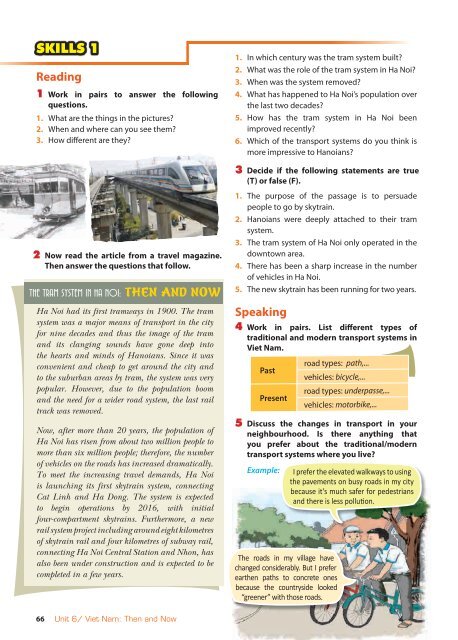Sách giáo viên Tiếng Anh 9 Thí điểm 2 tập (Pilot English 9 for Teacher)
https://app.box.com/s/rnv2yu1duebjhdpkknu2l47p9nmel5ax
https://app.box.com/s/rnv2yu1duebjhdpkknu2l47p9nmel5ax
You also want an ePaper? Increase the reach of your titles
YUMPU automatically turns print PDFs into web optimized ePapers that Google loves.
SKILLS 1<br />
Reading<br />
1 Work in pairs to answer the following<br />
questions.<br />
1. What are the things in the pictures?<br />
2. When and where can you see them?<br />
3. How different are they?<br />
2 Now read the article from a travel magazine.<br />
Then answer the questions that follow.<br />
THE TRAM SYSTEM IN HA NOI: THEN AND NOW<br />
Ha Noi had its first tramways in 1900. The tram<br />
system was a major means of transport in the city<br />
<strong>for</strong> nine decades and thus the image of the tram<br />
and its clanging sounds have gone deep into<br />
the hearts and minds of Hanoians. Since it was<br />
convenient and cheap to get around the city and<br />
to the suburban areas by tram, the system was very<br />
popular. However, due to the population boom<br />
and the need <strong>for</strong> a wider road system, the last rail<br />
track was removed.<br />
Now, after more than 20 years, the population of<br />
Ha Noi has risen from about two million people to<br />
more than six million people; there<strong>for</strong>e, the number<br />
of vehicles on the roads has increased dramatically.<br />
To meet the increasing travel demands, Ha Noi<br />
is launching its first skytrain system, connecting<br />
Cat Linh and Ha Dong. The system is expected<br />
to begin operations by 2016, with initial<br />
four-compartment skytrains. Furthermore, a new<br />
rail system project including around eight kilometres<br />
of skytrain rail and four kilometres of subway rail,<br />
connecting Ha Noi Central Station and Nhon, has<br />
also been under construction and is expected to be<br />
completed in a few years.<br />
1. In which century was the tram system built?<br />
2. What was the role of the tram system in Ha Noi?<br />
3. When was the system removed?<br />
4. What has happened to Ha Noi’s population over<br />
the last two decades?<br />
5. How has the tram system in Ha Noi been<br />
improved recently?<br />
6. Which of the transport systems do you think is<br />
more impressive to Hanoians?<br />
3 Decide if the following statements are true<br />
(T) or false (F).<br />
1. The purpose of the passage is to persuade<br />
people to go by skytrain.<br />
2. Hanoians were deeply attached to their tram<br />
system.<br />
3. The tram system of Ha Noi only operated in the<br />
downtown area.<br />
4. There has been a sharp increase in the number<br />
of vehicles in Ha Noi.<br />
5. The new skytrain has been running <strong>for</strong> two years.<br />
Speaking<br />
4 Work in pairs. List different types of<br />
traditional and modern transport systems in<br />
Viet Nam.<br />
Past<br />
Present<br />
road types: path,...<br />
vehicles: bicycle,...<br />
road types: underpasse,...<br />
vehicles: motorbike,...<br />
5 Discuss the changes in transport in your<br />
neighbourhood. Is there anything that<br />
you prefer about the traditional/modern<br />
transport systems where you live?<br />
Example:<br />
The roads in my village have<br />
changed considerably. But I prefer<br />
earthen paths to concrete ones<br />
because the countryside looked<br />
“greener” with those roads.<br />
I prefer the elevated walkways to using<br />
the pavements on busy roads in my city<br />
because it’s much safer <strong>for</strong> pedestrians<br />
and there is less pollution.<br />
66 Unit 6/ Viet Nam: Then and Now

















